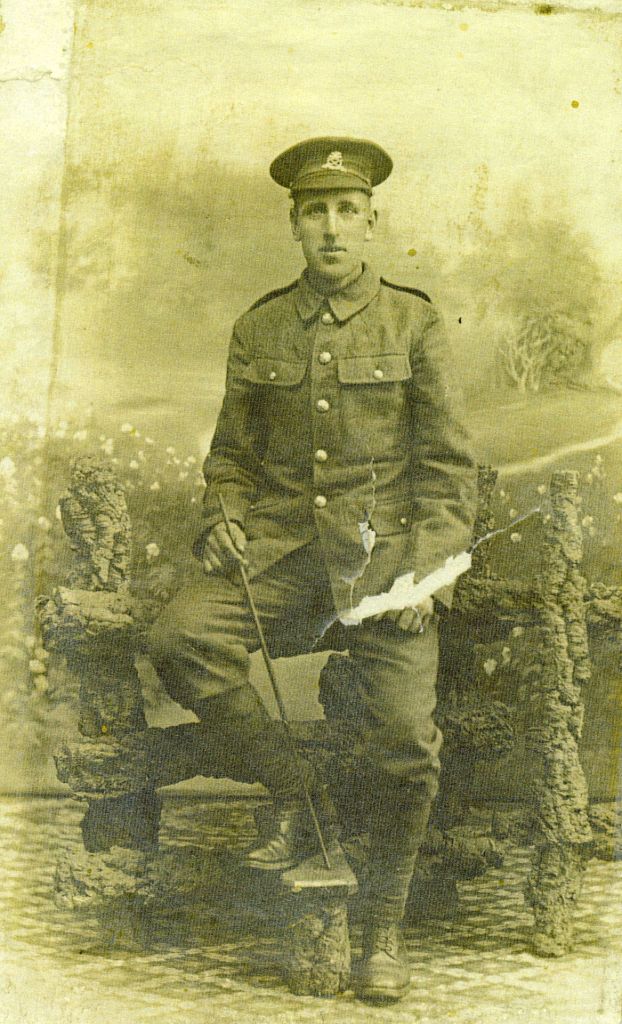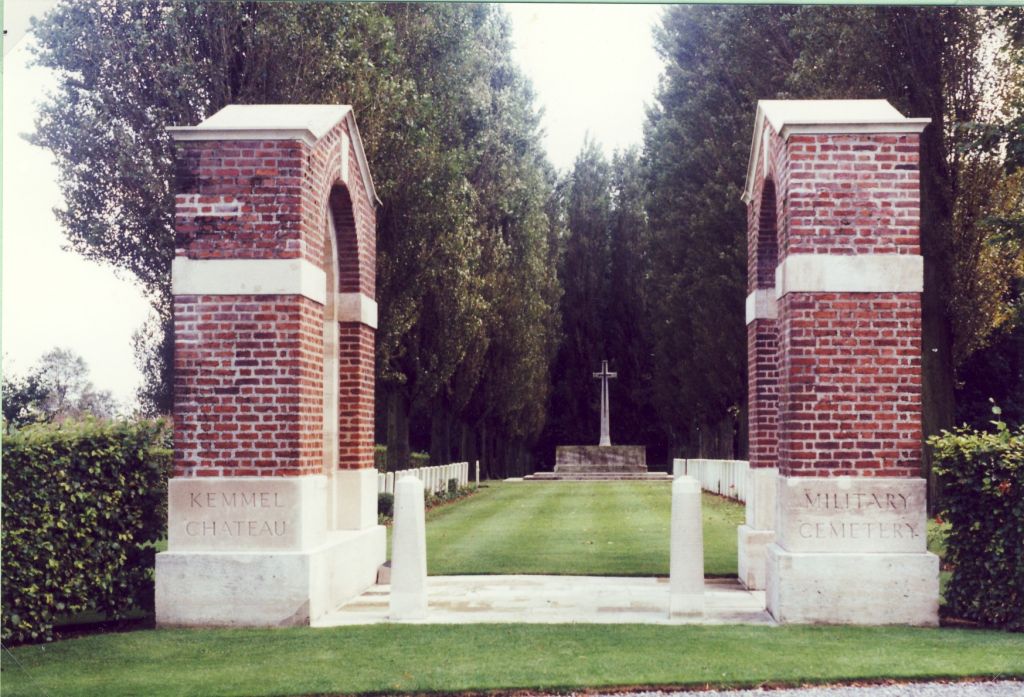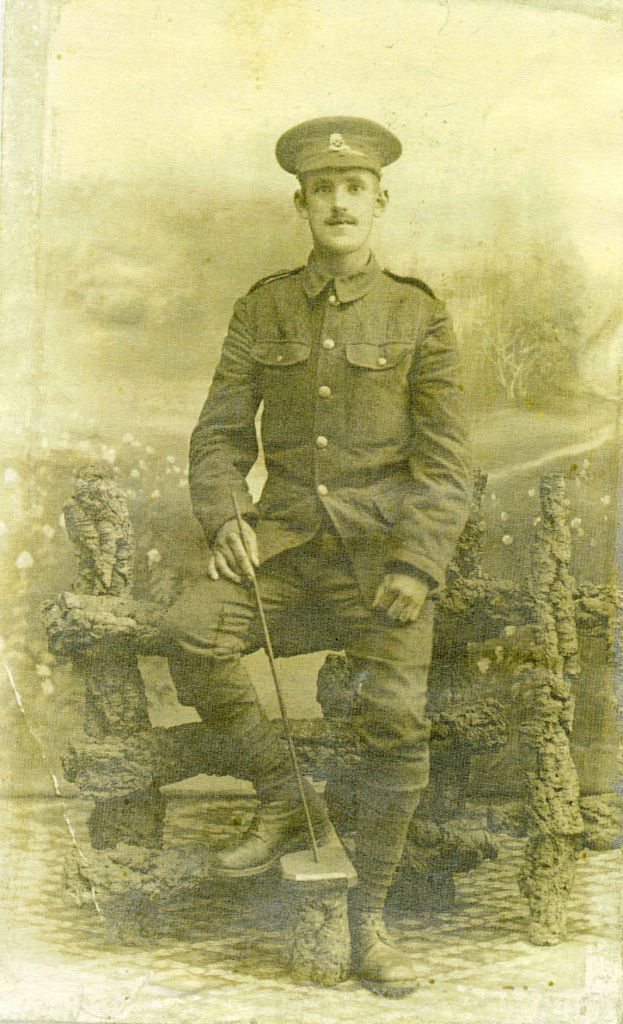Eli Hodgetts
Date of birth: 1886
Date of death: 30.7.1917
Area: Castleford
Regiment: North Staffordshire (Prince of Wales's)
Family information: Son of James and Hannah Hodgetts
Rank: Private
Service number: 13091
War Service
Eli enlisted with his brother Tom in Castleford on September 7th, 1914. He was passed as fit for service on the 11th. Eli and Tom joined the North Staffs because their father originally came from Staffordshire with his parents. On his enlistment he is described as 5ft 8ins tall, 126lb in weight, of sallow complexion with blue eyes and brown hair.
Once they had enlisted, Eli and Tom were sent for training (their Battalion was formed at Lichfield on September the 18th), and then attached as Army Troops to the 22nd Division. In April 1915, they were transferred as a Pioneer Battalion to the 37th Division., moving to Cholderton, near Amesbury in Wiltshire.
On 27th July 1915 at 5.30p.m. they set sail from Southampton in the “La Marguerite” and disembarked at Le Havre, France on the 29th at 2a.m. Over the next few weeks they travelled to Le Sceaur near Nieppe, via St. Omer, Tigues, Lynde and Rouge Croix, to dig trenches.
They were moved by train at the end of August to Doullens, then in early September via Authieule to Warlincourt and Pommier. Eli and Tom spent the hard, wet winter of 1915-16 (400 pairs of long gum boots were issued on 23rd November), cutting wood, revetting and draining trenches in the Berles and Bienvillers area.
After February, they worked on light gauge railways and snow clearance. On March 24th they moved from Bienvillers to Occoches and Outrebois where the work was less strenuous, but the weather was particularly bad.
At the beginning of June they were in Pas then Henencourt and Albert on to “Gordon Post” and “Sausage Valley”, then to Bresle on the Somme working mainly on light railway and road work.
In August they were at Fricourt Wood during the battle of the Somme then to various places then, in September to “Fosse 10” – a forward position (probably the RE Dump) on the 22nd of September.
There were a lot of movements in October. In November – with a big push on the way – they were sent to Gezaincourt then back to Hedauville camp.
Eli was wounded by shrapnel on 21st November and evacuated to the Casualty Clearing Station at Etaples. Etaples Camp was composed of tents, with large marquees used as dining halls and a few wooden buildings used by the YMCA Church Army and others used as rest huts adjacent to the camp. He was moved to the Base Hospital at Calais on the 29th when he was fitted with dentures. The shrapnel had damaged his jaw and teeth and as he spent four months recuperating it must have been a serious wound.
On the 4th April 1917 he re-joined his regiment at Moncheaux as part of a draft of nine men moving to Warlus near Arras on the 8th, where he was immediately flung into an attack at 5.30a.m. the next day on the Cambrai road. Moving through Laurent Blagny five days later he was in Athies for an attack on Gavrelle, returning to Liencourt after being relieved on the 30th.
After a fourteen day rest Eli moved on to Arras. June was busy towards the end of the month, he worked on the Cheapside trench near Kemmel, then Beaver Corner and the light railway at Oostaverne, often under sniper and shell fire.
Eli was with C company and during July they were at Mt Kemmel/Wytschate on BOB trench for the first nine days, moving on to Manchester Street, also a trench, widening and deepening and improving its drainage and laying trench boards. It was continuous hard and dangerous work, under shell-fire and gas attacks.
Tom had been in a different working group to Eli and was on his way out to work in the trenches as Eli was returning to billet in the early morning after working through the night of Sunday the 29th. The brothers met each other in passing – it was the last time Tom would see his brother alive. Eli, last in line, was hit by a shell and killed. Tom saw what was left of his brother’s body – he would never forget what he saw.
Eli was buried the next day 8 kilometres south of Ieper (Ypres) attended by his brother Tom. The attack for which he had been working took place 24 hours later at 3.50a.m. on Tuesday 31st July.
Family Life
Eli, my father’s uncle, was born in Silkstone Row, Altofts in 1886, one of seven children – six brothers and one sister. His parents Hannah and James had met after moving to Yorkshire with their own parents from Derbyshire and Staffordshire respectively. When he was a toddler, the family moved to New Fryston where his father and two oldest brothers worked at the local colliery and where he later attended school, his maternal grandfather also lived with them.
By 1901 the family lived in Castleford but their father and grandfather had both died, one brother had married and left home and Eli and all his brothers worked at Glass Houghton Colliery where Eli was a pony driver. Sister Eliza had married and her husband lived with the family. By 1914 Eli’s mother had died and Eli, Tom and another unmarried brother lived with sister Eliza, her husband and family in Robin Hood Street, Castleford.
Whilst Eli and Tom were in Flanders, the family at home wrote often and were pleased to receive letters and embroidered post cards back from the front proving that Eli and Tom were still alive and well. Sad events overtook the family whilst they were away, their two young nephews, sons of their brother James became ill and died – one from the Influenza epidemic that was sweeping through Castleford.
Although her youngest brothers Eli and Tom worked hard and enjoyed a drink, Eliza was very fond of them. She was named as Eli’s next of kin when he enlisted and received his effects when he was killed. Three photographs and a disc were forwarded to her on 12th February 1918 and his medals in 1919 and in July 1921.
Her brother Tom was discharged from the army on the 20th February 1919.
It was Eliza who received letters from Eli’s commanding officer, 2nd Lt Rudge, from the Padre, a comrade and his best friend telling how he died and how he was a good soldier, popular with his regiment.
His commanding officer wrote: “He was always bright always cheery and always had a joke on his lips” and that “In hard work and personal bravery he set an example to all. He will be taken to his last resting-place by his pals and his brother”.
From the Padre: “He is a great loss, ever cheery in the face of difficulties and is well spoken of by all”.
From a Comrade: “Eli happened to be the last man and a shell dropped quite close to him, the concussion alone would have been enough to kill him”.
From his pal C H Dent: “The boys in the section have asked me to write a few lines to you. We were always the best of pals Eli and I; we have been practically together for 3 years. He was a soldier every inch and died a soldier”.
Every year Eliza put a memorial for her brother in the local paper and she named her son Thomas Eli (known as Eli), in his memory.
Eliza wanted Eli never to be forgotten and thanks to this project and to Phil Judkins for his help and advice in researching Eli’s story, I hope that he never will be.
 Eli Hodgetts
Eli Hodgetts
 Kemmel Chateau entrance
Kemmel Chateau entrance
 Kemmel Chateau graveyard
Kemmel Chateau graveyard
 Thomas Hodgetts
Thomas Hodgetts

